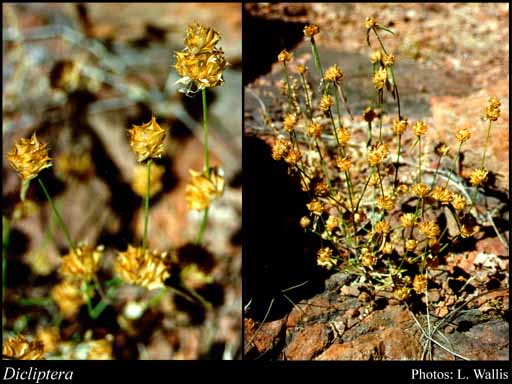- Reference
- Ann.Mus.Natl.Hist.Nat. p267 (1805)
- Name Status
- Current







Scientific Description
Family Acanthaceae.
Habit and leaf form. Herbs, or shrubs (subshrubs, with cystoliths). The herbs annual to perennial. Young stems 6-angled. Hydrophytic, or helophytic, or mesophytic, or xerophytic. Leaves opposite (decussate); gland-dotted, or not gland-dotted; simple. Leaf blades entire; flat; pinnately veined, or palmately veined; cross-venulate. Leaves without stipules. Leaf blade margins entire. Stem anatomy. Nodes unilacunar. Secondary thickening developing from a conventional cambial ring. Roots. Aerial roots present, or absent.
Reproductive type, pollination. Fertile flowers hermaphrodite. Unisexual flowers absent. Plants hermaphrodite. Entomophilous. Pollination mechanism conspicuously specialized, or unspecialized.
Inflorescence and flower features. Flowers aggregated in ‘inflorescences’; in loose or dense fan-like aggregations of 1–5 bracteate clusters; each bracteate cluster consisting of 1–5 shortly pedunculate pairs of unequal, appressed and spine-tipped bracts, each cluster subtended by a pair of keeled spines and within each bract pair 2 or more 2-bracteolate flowers either chasmogamous or cleistogamous. The terminal inflorescence unit cymose, or racemose. Inflorescences axillary; with involucral bracts, or without involucral bracts; pseudanthial, or not pseudanthial. Flowers bracteate. Bracts free, enclosing tube of chasmogamous flower and mature capsules. Flowers bracteolate. Bracteoles tiny, smaller than calyx lobes. Flowers very irregular; zygomorphic. The floral asymmetry involving the perianth and involving the androecium. Flowers 4 merous, or 5 merous; tetracyclic. Free hypanthium absent. Hypogynous disk present; thickened. Perianth with distinct calyx and corolla; 9, or 10; 2 -whorled; isomerous, or anisomerous. Calyx 5; 1 -whorled; gamosepalous (at base); lobed; with the median member posterior. Corolla 4, or 5; 1 -whorled; gamopetalous; imbricate, or contorted, or with open aestivation; the chasmogamous flower with narrow tube twisted through 180 degrees, widening apically into throat; the cleistogamous flower with a tiny, tubular corolla, not twisted through 180 degrees, the lobes very short, remaining closed about stamens; bilabiate. Androecium 2. Androecial members adnate; all equal; free of one another; 1 -whorled. Stamens 2; becoming exserted, or remaining included (rarely); reduced in number relative to the adjacent perianth; oppositisepalous; all alternating with the corolla members. Filaments hairy (in lower half). Anthers dorsifixed; dehiscing via longitudinal slits; bilocular (linear or more or less globose in chasmogamous flowers, subglobular in cleistogamous flowers); tetrasporangiate; unappendaged. Pollen shed as single grains. Gynoecium 2 carpelled. The pistil 2 celled. Gynoecium syncarpous; synstylovarious to eu-syncarpous; superior. Ovary plurilocular; 2 locular. Gynoecium median. Ovary sessile. Styles 1; long, equally 2-lobed at apex in chasmogamous flowers; short, entire or unequally 2-lobed at apex in cleistogamous flowers; attenuate from the ovary; apical; much longer than the ovary at anthesis; becoming exserted, or not becoming exserted. Stigmas 1, or 2; dry type; non-papillate; Group II type. Placentation axile. Ovules 1 per locule, or 2 per locule; non-arillate, or arillate; hemianatropous, or anatropous, or campylotropous.
Fruit and seed features. Fruit non-fleshy; dehiscent; a capsule (compressed, more or less circular in outline with thickened circumference). Capsules loculicidal (splitting medianly into 2 valves which are projected upwards with further splitting). Fruit elastically dehiscent. Dispersal unit the seed. Fruit 1 seeded, or 2 seeded. Seeds discoid; non-endospermic; conspicuously hairy, or not conspicuously hairy. Embryo well differentiated. Cotyledons 2. Embryo achlorophyllous; curved. Testa smooth, or with tubercles (tubercles sometimes with barbs (glochidiate)). Seedling. Germination phanerocotylar.
Physiology, biochemistry. Aluminium accumulation not found.
Special features. The seeds on elongated, indurated, hook-shaped funicles (‘retinacula’). The upper (posterior, adaxial) lip of the corolla of chasmogamous flowers, shortly 3 lobed. Lower (abaxial) lip of the corolla entire, or bilobed (then notched).
Geography, cytology, number of species. Native of Australia. Not endemic to Australia. Australian states and territories: Western Australia, Northern Territory, and Queensland. Northern Botanical Province.
Additional characters Fruit shortly rostrate.
Taxonomic Literature
- Wheeler, J. R.; Rye, B. L.; Koch, B. L.; Wilson, A. J. G.; Western Australian Herbarium 1992. Flora of the Kimberley region. Western Australian Herbarium.. Como, W.A..
- Hara, Hiroshi 1984. Comment on species of Dicliptera.